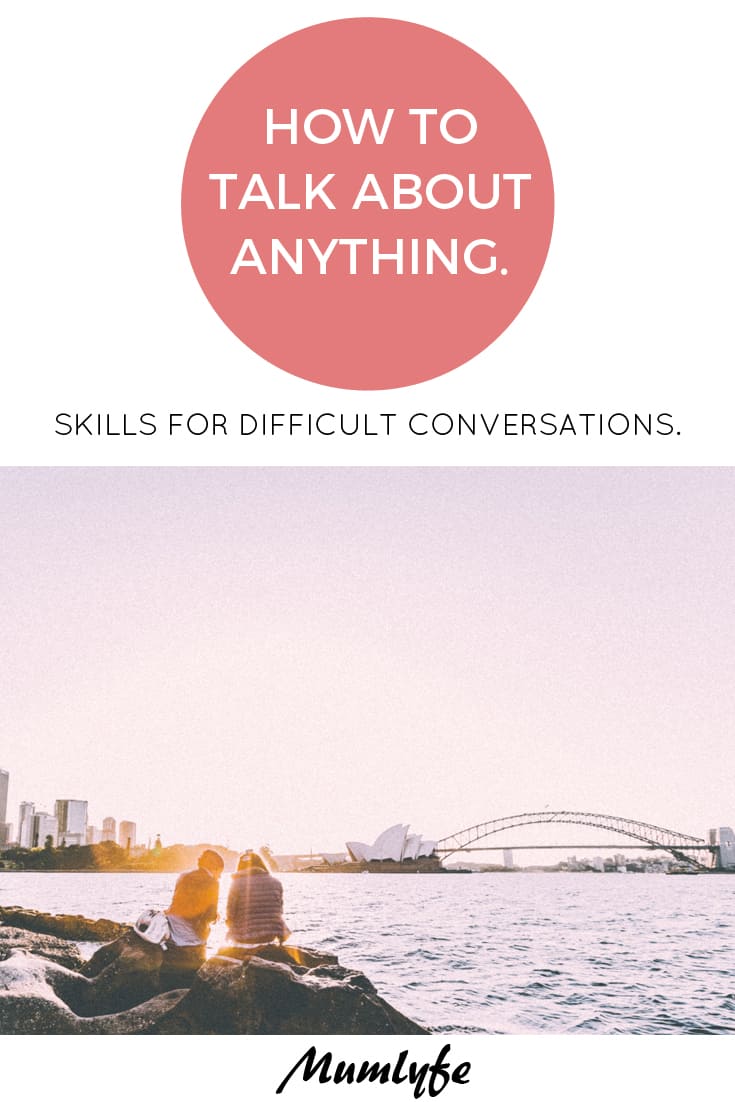It’s a fact of life that at some stage or another, our kids are going to have to tackle any number of difficult conversations. Matter of fact, many of the difficult conversations our kids will need to have will be with us.
These are the kind of conversations that many of us shy away from (me!). Others tackle difficult conversations too hastily and aggressively, leading to arguments and tension. Some of us start out strong and forthright, only to find ourselves overwhelmed by tears and frustration, still no solution in sight.
No doubt about it, difficult conversations, or ‘crucial conversations‘ as they’re called in my favourite book on the topic, are challenging. Thankfully there are some pretty simple tips and techniques for fronting up to a touchy discussion that we can learn and pass onto our kids.
Why are some discussions so hard?
The authors of Crucial Conversations reckon that there are three conditions that make a discussion challenging.
1. High stakes. The outcome of the discussion will have a big impact on you.
2. Strong emotion. No ambivalence here. This topic gives you all the feels – the good and the bad.
3. Opposing views. You think one thing. Your discussion partner thinks quite another.
Keep emotions in check
Some people handle difficult conversations with aplomb. They’re cool, calm and collected. Important messages are conveyed clearly. No one gets upset. A mutually agreeable solution is found. Everyone is happy. Tick. Sorted.
A mutually agreeable solution is found. Everyone is happy. Tick. Sorted.
Of course, these people are the minority. Most of us muddle through trailing degrees of conversation carnage, largely because our logic is hijacked by our emotion. You can bet that our tweens and teens will most likely take this approach!
Many parents fall into the trap of matching their child’s anger or frustration. The ‘discussion’ is very quickly hijacked by ‘argument’ and invariably ends with tears on one or both sides, nothing resolved and a few slammed doors.
Our brains are wired to perceive threats (and threats to your ego count!) and unless we step in with some conscious management of our emotion, they can quickly swamp our logic.

5 steps for successfully navigating challenging conversations
Step 1: Have a plan.
Sounds obvious but it’s amazing how often we launch into these discussions without giving much thought to what we want to achieve.
What’s your goal for the conversation? What outcome do you want? This is not about winning or punishing the other person, or keeping the peace. What solution do you want from this conversation? Think it through first. Be as specific as possible and bear that goal in mind throughout.
This might help: 10 ways to deal with back-talk without going full Hulk mum
Step 2: Put yourself in their shoes.
You’ll need your imagination for this part, especially if you’re dealing with an illogical teen. Consider for a moment where the other person in this conversation is coming from.
What’s driving the response or reaction that you anticipate from them? Are they frustrated? Angry? Scared? Confused? Do they see or understand the situation in the same way that you do? How do you know? Are you making assumptions about their point of view?
Try to understand their perspective. You don’t have to agree with it, but you increase the chances of a useful outcome if you go in trying to understand their perspective.
Try to understand their perspective. You don’t have to agree with it.
Step 3. Ask questions.
A key feature of any useful conversation is that both parties share their thoughts, listen to each other and build on (not destroy) the contribution of the other party to work towards a mutual solution. You can only do that if at least one party asks questions.
Especially true when discussing tricky subjects with your kids: be the one to put your opinion on hold and seek to understand. Ask questions. Clarify. Use ‘solution-focused’ questions such as, ‘How do you think we could…?’ and ‘What is the best outcome for both of us?’
Step 4: Look for the win, with respect.
Somewhere in your conversation there will be a mutual purpose. A place where you can both win, at least a little bit. Look for that place. Remember too that when having a difficult conversations with your kids, we need to take a step back and be the ‘referee’ as well as the player.
Maintain respect, acknowledge the other person’s frustration or anger or distress (as well as your own), and remember your goal for the conversation. Stay focused on that outcome and try not to let emotion overwhelm you.
You got this: 5 resilience tips to help you through tough times
Step 5: Practice.
This stuff ain’t easy and like anything, practice makes better, if not perfect. A good lesson for us to learn alongside our kids. The next time you have to have a difficult conversation, try these tips, but don’t beat yourself up if it doesn’t go to plan.
Remember, even psychologists find this stuff hard 😉.
Do you have a trusty strategy for difficult conversations?
Image by Alex wong



